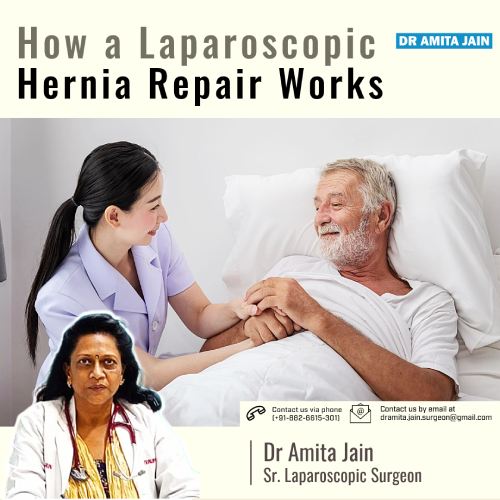A hernia is a gap or hole in the tough abdominal tissue. Weakness in this tissue allows organs like intestines to protrude, forming a sac. This condition can lead to pain or complications, necessitating urgent surgery to repair the hernia and prevent further issues. Hernias affect both genders, though they are more common in men.
A ventral hernia occurs in the abdominal region, typically near a surgical scar, which is the location where a surgeon made an incision during a previous operation. Such hernias can also manifest around the navel or any other area on the abdomen.
Dr Amita Jain, who is one of the best hernia repair surgeons in Delhi in the field of laparoscopic surgery explains the procedure in this article.
What are the Causes of Ventral Hernia?
Ventral hernias occur when certain areas of the abdomen weaken. Causes include injury, obesity, or previous abdominal incisions, especially if there was an infection after surgery. Hernias can develop at any age but become more common with age. Activities like frequent coughing or straining during urination or bowel movements can increase the risk.
Ventral hernias come in varying degrees of seriousness, and not all of them necessitate surgical intervention. However, if an organ becomes trapped (incarceration) or its blood supply is compromised (strangulation), emergency surgery is imperative. A surgeon can repair the hernia by either making a single large incision (referred to as “open” surgery) or using multiple small incisions, a technique known as laparoscopic or robotic ventral hernia repair, which falls under minimally invasive surgery. This procedure involves bringing the displaced tissue together and reinforcing the gap with mesh for added strength.
Preparation before surgery
Dr Amita Jain says to take the following precautions before the surgery:
- Quit smoking 4-6 weeks before surgery to lower hernia recurrence and infection risk.
- Stop specific medications (aspirin, blood thinners, Vitamin E) as per surgeon’s advice.
- Shower with antibiotic soap the night before/morning of surgery.
- Follow fasting instructions to ensure empty intestines.
- Take allowed medications on surgery day with a sip of water.
What is The Procedure?
Some of the procedures involved are:
- The procedure begins with the administration of general anaesthesia to ensure the patient is comfortable and pain-free during the surgery.
- Instead of a large abdominal incision, the surgeon makes three to four small incisions in the abdomen.
- A narrow tube-like device called a port is then inserted.
- A camera (laparoscope) is then introduced through the port to provide visual guidance.
- The surgeon corrects the hernia, removes scar tissue, repositions muscle tissues, and places a surgical mesh under the hernia to prevent recurrence, securing it with tacks or sutures.
- Additional ports and instruments are used for the procedure, resulting in 3 to 5 small incisions.
- A mesh patch may be employed to reinforce the repair as needed.
What are the Risks involved?
- General anaesthesia poses higher risks for older individuals and those with underlying health issues. Common complications encompass nausea, vomiting, urinary retention, sore throat, and headaches. More severe issues may involve heart attacks, strokes, pneumonia, and leg blood clots.
- Internal bleeding within the incision is a rare but serious complication of inguinal hernia repair, leading to significant swelling and bluish skin discolouration. Surgical intervention is typically required to address this issue, affecting less than 2% of patients.
- The risk of wound infection, at less than 2%, is higher in older adults and those with complex hernia repairs. Symptoms include fever, incision discharge, redness, swelling, and tenderness. Treatment involves antibiotics and, if necessary, a minor procedure to drain the infection.
- Some people may feel sharp, tingling pain near a healed incision, but it often goes away with time. If the pain persists, medication can be injected into the area for relief.
What are the Benefits of Laparoscopic Repair?
- Quicker recovery: Patients recover faster with less postoperative pain.
- Minimal scarring: Small incisions for cosmetic appeal.
- Reduced infection risk: Smaller incisions and shorter hospital stays.
It’s important to consult with a healthcare professional to determine the best course of action for hernia repair, as each case is unique. Remember, early intervention and repair can make all the difference in living a comfortable and healthy life.

Dr Amita Jain is a surgeon with highest degree of professional competence, precision and surgical craftsmanship. Performed all complicated general surgery procedures with in depth knowledge of invasive and few minimal invasive and onco surgical techniques. Underwent special training in trauma, executed various trauma-related complex life-saving neurosurgical procedures, reconstructed injured mangled limbs and performed vascular and reconstructive procedures with critical care.
Dr Amita Jain holds 28 plus years of rich experience in Trauma and General Laparoscopic Surgeries (including Gallbladder stone removal, appendix removal, hernia repair surgery, piles and fissure surgeries). She was the Professor Surgery of at the Army College of Medical Sciences and Base Hospital Delhi Cantt. In 1994 she was commissioned as Surgeon under the United Nations Mission in Congo. From 2020 to 2022, she worked with Bansals Hospital. Currently, Dr Amita Jain is the Senior Consultant, (Speciality: General and Laparoscopic Surgeon) at Artemis Lite Hospital, New Delhi

